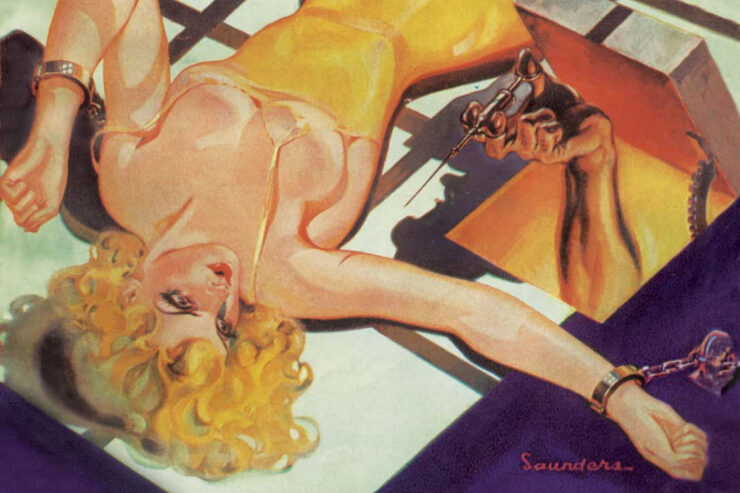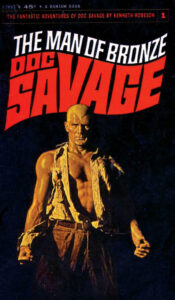 Pulp magazines have influenced writers, artists, film directors, software developers, and countless others over the years. Our “PulpFest Profiles” focus on contemporary creators who have drawn inspiration from these rough-paper fiction magazines.
Pulp magazines have influenced writers, artists, film directors, software developers, and countless others over the years. Our “PulpFest Profiles” focus on contemporary creators who have drawn inspiration from these rough-paper fiction magazines.
Sara Light-Waller (SLW): John Gunnison’s Adventure House is my first shopping stop at every pulp convention. There’s always something wonderful to see, and even books that I can afford to purchase! His reprints are of special interest to me, I keep a bunch on hand for research purposes. I’m excited to find out more about Adventure House and I’ll bet you are, too!
Let’s start with some basics. John, when did you first catch the “pulp bug”?
John P. Gunnison (JPG): That would be way back in the mid-1960s. That’s when I got hooked on Doc Savage, The Avenger, The Spider, and The Shadow, all of which were being reprinted by Bantam Books and other paperback publishers at the time. I’ve related this before, but I was reading a Doc Savage paperback in our living room one day when my mom walked by and was gob-smacked at what I was reading. She’d been a Doc Savage fan back in 1933 or 1934. Her dad ran a shoe store in their little town in Northwest Pennsylvania. Down the block was an apothecary with a newsstand inside and that’s where she bought her Doc Savage pulps. She had a vague remembrance of keeping her copies through the years and thought they might still be in our attic. Alas, after an eager afternoon of searching, I still came up empty.
SLW: When did you start collecting pulps?
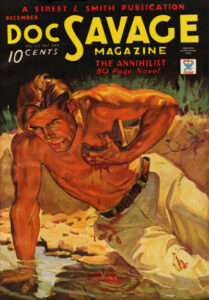 JPG: I was trying to collect pulps in the late 1960s while also collecting comics. But the pulps seemed very expensive, especially when I got catalogs from Howard Rogofsky. It wasn’t until sometime in 1969 or 1970 that I really got started. I was attending a comic show at the University of Maryland and spied a table full of pulps from a local dealer — Joe Goggin. I picked up one of his oldest, and yet, least expensive pulps. I went home with a smaller pile of comics and my first pulp, the December 1934 issue of Doc Savage Magazine, featuring “The Annihilist.” The race was on!
JPG: I was trying to collect pulps in the late 1960s while also collecting comics. But the pulps seemed very expensive, especially when I got catalogs from Howard Rogofsky. It wasn’t until sometime in 1969 or 1970 that I really got started. I was attending a comic show at the University of Maryland and spied a table full of pulps from a local dealer — Joe Goggin. I picked up one of his oldest, and yet, least expensive pulps. I went home with a smaller pile of comics and my first pulp, the December 1934 issue of Doc Savage Magazine, featuring “The Annihilist.” The race was on!
SLW: I understand that you had Pulp Collector Press before it later became Adventure House. How did the two businesses differ and what prompted the change of name?
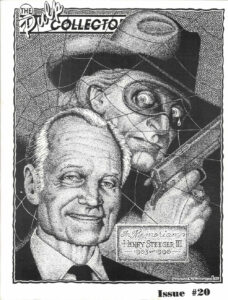 JPG: Pulp Collector Press was fine to publish fanzines. But when I started branching out into reprints, my friend John Locke suggested I change the name to something broader. Most people had no clue what a “pulp” was. At the time, I had a custom license plate on my car which simply read, “PULP.” People asked all the time if I was particularly fond of orange juice. So, Adventure House it was!
JPG: Pulp Collector Press was fine to publish fanzines. But when I started branching out into reprints, my friend John Locke suggested I change the name to something broader. Most people had no clue what a “pulp” was. At the time, I had a custom license plate on my car which simply read, “PULP.” People asked all the time if I was particularly fond of orange juice. So, Adventure House it was!
SLW: You are an important contributor to the pulp reprint market. What first inspired you to start creating pulp reprints and/or get into the reprint market?
JPG: When I was a senior in high school I won several awards within the printing industry, and planned on attending R.I.T. in Rochester, New York. Although I ended up on a slightly different path, I knew I wanted to publish printed materials. I felt I could do a better job than most of the pulp fanzine material out there. I went to the extra expense of publishing The Pulp Collector as a perfect bound book. My next step was to produce pulp reprints/adzines. Because my cash flow was limited, I had the covers printed on colored card stock. I printed the interiors myself. Although ads didn’t come in, subscriptions increased. This allowed me to print the covers in color and attach them to the black and white interiors as I had done with the card stock covers. Eventually, I went to a printer in Florida and started printing a minimum of 1000 copies. Today, Amazon does my reprints.
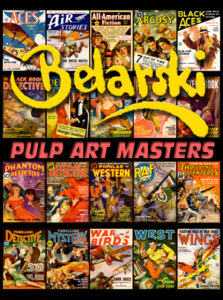 As the business grew, I began a series of pulp-related anthologies. These were printed as 7” x 10” books. Sales were decent, which just whetted my appetite to try more. After buying a large run of pulp proofs from the Rudolph Belarski estate, I created the first of two of my Pulp Art Master books. I used a printer in Hong Kong and produced 3000 copies of Rudolph Belarski: Pulp Art Master. It sold well enough that I felt that I could expand. I borrowed a large number of Walter Baumhofer’s pulp art proofs from Illustration House and I went back to the same printer in Hong Kong, this time for nearly 5000 copies. For various reasons this book didn’t sell as well and I still have thousands of copies sitting in my “warehouse” in my backyard. Other publications came and went, but what started out as Pulp Review, and later became High Adventure, is now reaching its 200th issue.
As the business grew, I began a series of pulp-related anthologies. These were printed as 7” x 10” books. Sales were decent, which just whetted my appetite to try more. After buying a large run of pulp proofs from the Rudolph Belarski estate, I created the first of two of my Pulp Art Master books. I used a printer in Hong Kong and produced 3000 copies of Rudolph Belarski: Pulp Art Master. It sold well enough that I felt that I could expand. I borrowed a large number of Walter Baumhofer’s pulp art proofs from Illustration House and I went back to the same printer in Hong Kong, this time for nearly 5000 copies. For various reasons this book didn’t sell as well and I still have thousands of copies sitting in my “warehouse” in my backyard. Other publications came and went, but what started out as Pulp Review, and later became High Adventure, is now reaching its 200th issue.
With the advent of Print On Demand or POD printers, I got the bug to get into a fairly new — but expanding universe — of pulp reprints. I now have more than 730 titles published and Adventure House is still going strong.
SLW: What is the source for your reprints — your personal collection?
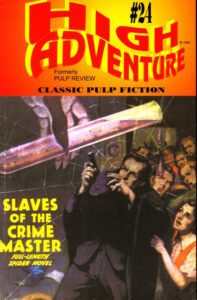 JPG: I first started reprinting by taking my own pulps apart and scanning them page by page. Realizing this couldn’t continue, I bought a specialty book scanner and am now able to scan books without taking them apart. I still have pulps I need to put back together, I’ll probably do that in another lifetime. When I buy a collection with coverless pulps, I’ll take them apart without feeling the need to put them back together.
JPG: I first started reprinting by taking my own pulps apart and scanning them page by page. Realizing this couldn’t continue, I bought a specialty book scanner and am now able to scan books without taking them apart. I still have pulps I need to put back together, I’ll probably do that in another lifetime. When I buy a collection with coverless pulps, I’ll take them apart without feeling the need to put them back together.
SLW: How do you choose which pulps to reprint, is it all planned, or does the list grow organically?
JPG: I’d love to say I read every pulp I reprint but that would be a bald-faced lie. I’m a very slow reader, so I reprint mostly based on rarity. If someone really wants to see what stories were like in a Spicy Mystery for example and doesn’t want to damage their expensive copy . . . well why not reprint those? Want to read a super-rare Gangster Stories from Harold Hersey? Adventure House is your publisher! Aviation, western, sports, detective, weird menace, hero — I’ve done just about all of them. Each and every one is printed in facsimile format because I don’t have the time to OCR, compile, and proofread all the books.
SLW: Currently, what are your most popular reprints?
JPG: Since my reprint books are printed and distributed through Amazon, there’s a difference between the books I sell from my website and those sold through Amazon. High Adventure is one of my best-selling titles on my website. The detective titles sell best on Amazon.
SLW: Adventure House also holds monthly, online auctions. What is the most exciting item you’ve ever sold at auction?
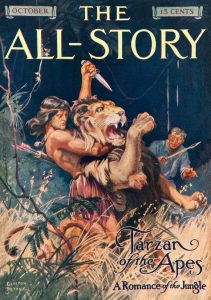 JPG: “Exciting” is sort of a nebulous idea. What excites one person might be ho-hum for another. But I’ve been the lucky avenue for a number of very high-profile collections. I’ve either sold or auctioned well over 150,000 pulp and pulp-related items. These have included the first edition of Robert E. Howard’s A Gent from Bear Creek, The All-Story featuring Burroughs’ “Tarzan of the Apes,” the New Story Magazine with “The Return of Tarzan,” several sets of Weird Tales (with Frank Robinson’s collection being the best-condition set ever assembled), several sets of The Shadow and Doc Savage Magazine, a complete set of Magazine Publishers’ short-lived Fire Fighters pulp, and more. I’ll admit that I’m kind of jaded but love it when I can connect a collector with some truly great material.
JPG: “Exciting” is sort of a nebulous idea. What excites one person might be ho-hum for another. But I’ve been the lucky avenue for a number of very high-profile collections. I’ve either sold or auctioned well over 150,000 pulp and pulp-related items. These have included the first edition of Robert E. Howard’s A Gent from Bear Creek, The All-Story featuring Burroughs’ “Tarzan of the Apes,” the New Story Magazine with “The Return of Tarzan,” several sets of Weird Tales (with Frank Robinson’s collection being the best-condition set ever assembled), several sets of The Shadow and Doc Savage Magazine, a complete set of Magazine Publishers’ short-lived Fire Fighters pulp, and more. I’ll admit that I’m kind of jaded but love it when I can connect a collector with some truly great material.
The worst part of my job is that I’m selling my late friends’ lifetime commitment to collecting pulps. I go all the way back to collectors like Lester Belcher, Sheldon Jaffery, Darrell Richardson, Andy Biegel, Frank Robinson, Glenn Lord, and more recently, Ed Gobbett.
SLW: How has the pulp market changed during your time in business?
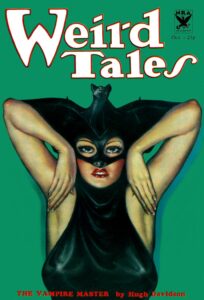 JPG: Pulps have always been kind of volatile. Titles and genres catch fire and prices spike. Because of the scarcity of copies, the number of collectors is fairly static. Recently, prices have hit new highs due to investors trying to pry loose those elusive books. This troubles me. As prices continue to rise on “key” pulps, the number of collectors could collapse, as they flee the market due to high prices. I’ve either known or still know, people with collections numbering in the thousands. Because of a new trend — collecting titles with a history of being better “investments” — collections will now be much smaller. This leaves the vast majority of pulps sitting and not being enjoyed. When I first got into collecting and selling, most collectors both enjoyed the art and the stories. Now, if you talk to any of the investment collectors, I’ll bet the majority couldn’t tell you much about their pulps, let alone having read even one story in any of them.
JPG: Pulps have always been kind of volatile. Titles and genres catch fire and prices spike. Because of the scarcity of copies, the number of collectors is fairly static. Recently, prices have hit new highs due to investors trying to pry loose those elusive books. This troubles me. As prices continue to rise on “key” pulps, the number of collectors could collapse, as they flee the market due to high prices. I’ve either known or still know, people with collections numbering in the thousands. Because of a new trend — collecting titles with a history of being better “investments” — collections will now be much smaller. This leaves the vast majority of pulps sitting and not being enjoyed. When I first got into collecting and selling, most collectors both enjoyed the art and the stories. Now, if you talk to any of the investment collectors, I’ll bet the majority couldn’t tell you much about their pulps, let alone having read even one story in any of them.
SLW: What are your future plans for Adventure House?
JPG: I plan on making High Adventure #200 the last issue of that title. It will be a special issue. My wife and friends have asked about my retirement plans. I normally look at them with horror at the idea. Retire? Nah! But I will slow down on publishing. Maybe reduce the number of auctions. I will certainly do fewer conventions. But I love what I do and plan on continuing until I physically can’t.
SLW: Anything else you’d like to mention?
JPG: My wife’s crafting passion has taken hold of me and I’ve been producing posters from the tens of thousands of covers I’ve scanned and retouched. I’m also in the midst of producing coasters featuring pulp and comic covers. I’ll have some of these on display at PulpFest and the Windy City Pulp And Paper Convention this year. They’ll also be available for sale on Etsy.
SLW: Thank you, John, for the delightful conversation. As a regular customer, I can tell you that I’m very excited about your ongoing plans for Adventure House!
You can reach John Gunnison through the Adventure House website. There you can purchase vintage pulp magazines, comic books, and other collectibles, as well as the many pulp replicas, reprints, and reference books published by Adventure House and others. You’ll also be able to register to bid in the latest Adventure House auction. And don’t forget to subscribe to the Adventure House Auctions YouTube Channel. You can do so by clicking here.
A professional journalist and illustrator with over thirty years of experience, Sara Light-Waller is an accomplished new-pulp fiction author/illustrator with three books out and more on the way. She is also the winner of the 2020 Cosmos Prize for her illustrated short story, “Battle at Neptune.” A huge pulp fan, Sara is especially fond of science fiction pulps. She is also a member of the PulpFest organizing committee and a regular contributor to our website and The Pulpster.
Our featured image is by Norman Saunders, excerpted from his cover painting for the October 1935 issue of Spicy Mystery Stories. A replica of the issue was published by John Gunnison’s Adventure House in April 2020.
Doc Savage #1 — The Man of Bronze — was published in 1966 by Bantam Books, with cover art by James Bama. Like many “baby boomer” pulp collectors, John Gunnison discovered the pulps through the paperback reprints of the 1960s and 70s.
Doc Savage Magazine for December 1934 with cover art by Walter M. Baumhofer was the first pulp to be purchased by John P. Gunnison. It featured “The Annihilist,” a Doc Savage adventure written by Lester Dent under the house name of Kenneth Robeson.
The Pulp Collector #20, dated Spring 1991, with cover art by Frank Hamilton. Published by John Gunnison, The Pulp Collector debuted in 1985 and ran for nearly a decade. Perfect bound, it was one of the leading pulp fanzines of its day.
Belarski: Pulp Art Masters was published by Adventure House in 2003. With text by John Gunnison, it featured nearly 350 full-color pulp covers painted by Rudolph Belarski, one of the leading cover artists for the pulp magazine and paperback book industries.
High Adventure #24 for November 1995 and featuring cover art by John Newton Howitt was the first issue of the Adventure House magazine under that title. Originally named Pulp Review, the magazine debuted in 1991. Reprinting classic stories from the pulps, it will soon reach its 200th issue.
The October 1912 issue of The All-Story featured Edgar Rice Burroughs’ novel “Tarzan of the Apes,” published in its entirety. Clinton Pettee — who illustrated many of the Munsey magazines as well as the pulp, Short Stories — painted the front cover art for the magazine.
A copy of Weird Tales for October 1933, featuring cover art by Margaret Brundage, recently sold for nearly $20,000. It’s thought to be one of the so-called “key” pulps. Click here for a Comic Connect video concerning the famous “Bat Woman” issue of “The Unique Magazine.”
Watch for our next PulpFest Profile in April when William Patrick Maynard will talk with Henry G. Franke III, the editor of The Burroughs Bulletin, the journal of The Burroughs Bibliophiles, the nonprofit literary society devoted to the life and works of Edgar Rice Burroughs.

